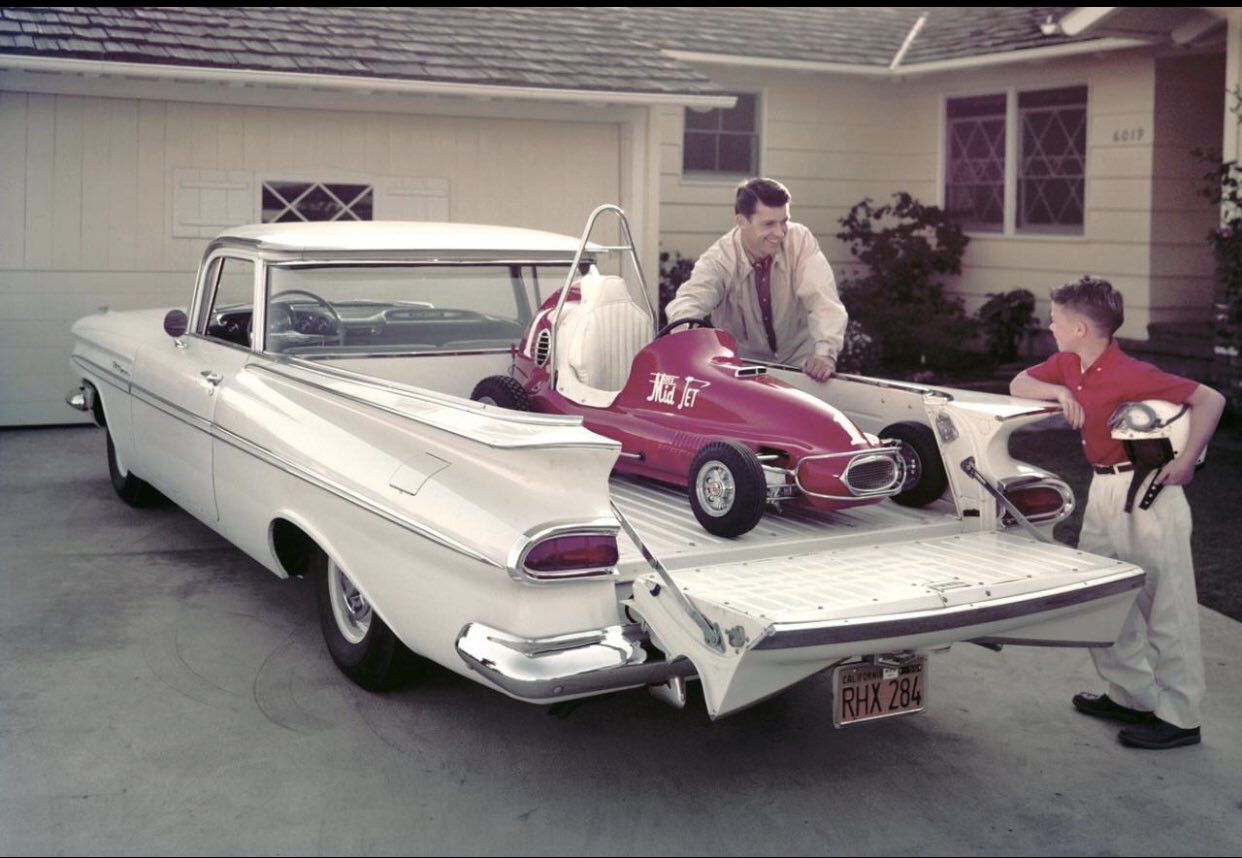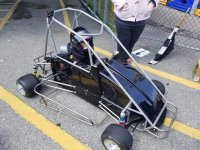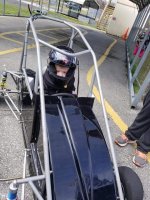So me and my girlfriend took her daughter to an Arrive and Drive event at Honey Brook Speedway here in PA today, where a few of the race teams let you try out a quarter midget, and long story short I'm now looking into getting her in one. Anyone have an experience or advice in what ti look out for? Video is her first ever laps driving anything.
You are using an out of date browser. It may not display this or other websites correctly.
You should upgrade or use an alternative browser.
You should upgrade or use an alternative browser.
1/4 Midgets
- Thread starter kkfan91
- Start date
Sorry that nobody answered... just stumbled onto this today so I'll try to help. I do not have direct experience with 1/4 Midgets, but I do have lots of experience with their racing kart cousins.
1. Decide what track(s) you want to race at, and get their rule books or at least talk to their promoters and tech men about what is legal and what classes they expect to run next year. You don't want to waste money on equipment that you later find you can't use. Particularly this effects engines and tires - typically the chassis rules are pretty stable.
2. Decide what kind of budget you can afford, and how seriously you intend to race. Budget because racing will eat every penny you're willing to throw at it. Serious because although older chassis will be cheaper, they also may not be good enough anymore to win. Personally I prefer to start kids out in older cheaper chassis and see if they are willing to put in the work and continual effort required to become a good racer before I spend a whole lot... however don't go too old and cheap because those chassis are usually just frustrating and teach kids bad driving habits. If it fits your budget I'd look at used cars that are no more than about six or so years old - those should be close enough to the latest technology to still be competitive yet cost less then three-quarters of a new one.
3. When looking at used cars, if you can find a really trusted shop or a trusted friend who knows what they're looking at it will help a lot. These cars can get flipped easily, and flipping can ruin a chassis. Look at all welds for cracks, and when you push the car across a flat surface it should roll straight. If there is a lot of stagger in the tires on it then it could be okay if it tends to steer itself to the left (gradually - not sharply). Somebody who knows these cars might weigh it out and help determine if the chassis is still sound, but unfortunately unless the chassis is badly out-of-whack you might not find it before trying to race it for a while... and you might not be sure if the problems are really your rookie driver or team.
4. Assume that you should buy all new safety gear, or at least new belts and helmet. If the seller throws in used safety gear that's nice, but when you care about your driver it's better to know how good your safety stuff really is.
5. If the car has dented wheels or scraped-up bodywork or paint that probably means it has seen abuse. Not always a deal breaker, but definitely a price negotiation point.
6. Assume that you'll need to buy new tires. Probably multiple sets, all mounted on good wheels. If the track allows tire prepping expect to spend a bunch of money on tires and tire prep chemicals.
7. Make sure a used motor starts up quickly and sounds okay. With a rookie driver you won't need the most horsepower out there because she'll have to learn how to use it, but obviously you don't want an engine with problems. I prefer to start in stock engine classes that do not allow engine modifications since those engines are usually very reliable and need little attention, which allows you to develop your chassis setups and driver skills (which are where the real speed is anyway).
8. Check what spare parts come with a used car. In karts we change gears (rear axle, and sometimes on the clutch) as track conditions change - ask, but that could be true for 1/4 Midgets too. You'll want another chain, engine tuneup parts, extra tires, and possibly even extra bolt-on weights. Those allow you to keep racing when you have problems at the track, instead of having to give up for the night. Ask other racers there what spares they keep. Also ask if there is a parts truck at the track.
9. Don't forget tools - particularly special tools needed to work on the chassis and its engine. You don't need to start out with all of the tools to completely rebuild the chassis or engine, but you do need any that are used to make adjustments. Here again, you don't have to start out with the very best versions of the special tools (such as an electronic scales set, when four bathroom scales can suffice). Or you might consider starting out paying others to do these things for you, but it's best if they allow you to see what they do and allow you to help - you'll learn how to successfully adjust things much quicker that way.
I suggest watching some regular races before starting to race yourself, just to know better what you're getting into. Sometimes you can find a good deal on a used car at the track. Realize that the general rule for successful racing is for every hour on the track there are about ten hours of prep time at home... that can change somewhat depending upon how serious you are and how tough your competition is. I also prefer to have rookie drivers start scratch (last) until they've driven enough races to demonstrate that they're getting the hang of it. No fun to draw a starting spot up front and then get run over.
If you can, find out if the track has practice days. If they do, also find out if you can get an experienced racer to give you some pointers then. Your driver was missing the fast lane around the track (which is to be expected since it was her first time) and it will be easier if somebody who knows the fast line around the track shows it to her. You can also get a better feel for the fast line by watching other races.
Best of luck!! Racing these things can be a lot of fun... and addicting...
1. Decide what track(s) you want to race at, and get their rule books or at least talk to their promoters and tech men about what is legal and what classes they expect to run next year. You don't want to waste money on equipment that you later find you can't use. Particularly this effects engines and tires - typically the chassis rules are pretty stable.
2. Decide what kind of budget you can afford, and how seriously you intend to race. Budget because racing will eat every penny you're willing to throw at it. Serious because although older chassis will be cheaper, they also may not be good enough anymore to win. Personally I prefer to start kids out in older cheaper chassis and see if they are willing to put in the work and continual effort required to become a good racer before I spend a whole lot... however don't go too old and cheap because those chassis are usually just frustrating and teach kids bad driving habits. If it fits your budget I'd look at used cars that are no more than about six or so years old - those should be close enough to the latest technology to still be competitive yet cost less then three-quarters of a new one.
3. When looking at used cars, if you can find a really trusted shop or a trusted friend who knows what they're looking at it will help a lot. These cars can get flipped easily, and flipping can ruin a chassis. Look at all welds for cracks, and when you push the car across a flat surface it should roll straight. If there is a lot of stagger in the tires on it then it could be okay if it tends to steer itself to the left (gradually - not sharply). Somebody who knows these cars might weigh it out and help determine if the chassis is still sound, but unfortunately unless the chassis is badly out-of-whack you might not find it before trying to race it for a while... and you might not be sure if the problems are really your rookie driver or team.
4. Assume that you should buy all new safety gear, or at least new belts and helmet. If the seller throws in used safety gear that's nice, but when you care about your driver it's better to know how good your safety stuff really is.
5. If the car has dented wheels or scraped-up bodywork or paint that probably means it has seen abuse. Not always a deal breaker, but definitely a price negotiation point.
6. Assume that you'll need to buy new tires. Probably multiple sets, all mounted on good wheels. If the track allows tire prepping expect to spend a bunch of money on tires and tire prep chemicals.
7. Make sure a used motor starts up quickly and sounds okay. With a rookie driver you won't need the most horsepower out there because she'll have to learn how to use it, but obviously you don't want an engine with problems. I prefer to start in stock engine classes that do not allow engine modifications since those engines are usually very reliable and need little attention, which allows you to develop your chassis setups and driver skills (which are where the real speed is anyway).
8. Check what spare parts come with a used car. In karts we change gears (rear axle, and sometimes on the clutch) as track conditions change - ask, but that could be true for 1/4 Midgets too. You'll want another chain, engine tuneup parts, extra tires, and possibly even extra bolt-on weights. Those allow you to keep racing when you have problems at the track, instead of having to give up for the night. Ask other racers there what spares they keep. Also ask if there is a parts truck at the track.
9. Don't forget tools - particularly special tools needed to work on the chassis and its engine. You don't need to start out with all of the tools to completely rebuild the chassis or engine, but you do need any that are used to make adjustments. Here again, you don't have to start out with the very best versions of the special tools (such as an electronic scales set, when four bathroom scales can suffice). Or you might consider starting out paying others to do these things for you, but it's best if they allow you to see what they do and allow you to help - you'll learn how to successfully adjust things much quicker that way.
I suggest watching some regular races before starting to race yourself, just to know better what you're getting into. Sometimes you can find a good deal on a used car at the track. Realize that the general rule for successful racing is for every hour on the track there are about ten hours of prep time at home... that can change somewhat depending upon how serious you are and how tough your competition is. I also prefer to have rookie drivers start scratch (last) until they've driven enough races to demonstrate that they're getting the hang of it. No fun to draw a starting spot up front and then get run over.
If you can, find out if the track has practice days. If they do, also find out if you can get an experienced racer to give you some pointers then. Your driver was missing the fast lane around the track (which is to be expected since it was her first time) and it will be easier if somebody who knows the fast line around the track shows it to her. You can also get a better feel for the fast line by watching other races.
Best of luck!! Racing these things can be a lot of fun... and addicting...
Thanks for the reply, we are still researching it, job situations with me and her mother changed so it's more of preparing for probably 2021 at the earliest.Sorry that nobody answered... just stumbled onto this today so I'll try to help. I do not have direct experience with 1/4 Midgets, but I do have lots of experience with their racing kart cousins.
1. Decide what track(s) you want to race at, and get their rule books or at least talk to their promoters and tech men about what is legal and what classes they expect to run next year. You don't want to waste money on equipment that you later find you can't use. Particularly this effects engines and tires - typically the chassis rules are pretty stable.
2. Decide what kind of budget you can afford, and how seriously you intend to race. Budget because racing will eat every penny you're willing to throw at it. Serious because although older chassis will be cheaper, they also may not be good enough anymore to win. Personally I prefer to start kids out in older cheaper chassis and see if they are willing to put in the work and continual effort required to become a good racer before I spend a whole lot... however don't go too old and cheap because those chassis are usually just frustrating and teach kids bad driving habits. If it fits your budget I'd look at used cars that are no more than about six or so years old - those should be close enough to the latest technology to still be competitive yet cost less then three-quarters of a new one.
3. When looking at used cars, if you can find a really trusted shop or a trusted friend who knows what they're looking at it will help a lot. These cars can get flipped easily, and flipping can ruin a chassis. Look at all welds for cracks, and when you push the car across a flat surface it should roll straight. If there is a lot of stagger in the tires on it then it could be okay if it tends to steer itself to the left (gradually - not sharply). Somebody who knows these cars might weigh it out and help determine if the chassis is still sound, but unfortunately unless the chassis is badly out-of-whack you might not find it before trying to race it for a while... and you might not be sure if the problems are really your rookie driver or team.
4. Assume that you should buy all new safety gear, or at least new belts and helmet. If the seller throws in used safety gear that's nice, but when you care about your driver it's better to know how good your safety stuff really is.
5. If the car has dented wheels or scraped-up bodywork or paint that probably means it has seen abuse. Not always a deal breaker, but definitely a price negotiation point.
6. Assume that you'll need to buy new tires. Probably multiple sets, all mounted on good wheels. If the track allows tire prepping expect to spend a bunch of money on tires and tire prep chemicals.
7. Make sure a used motor starts up quickly and sounds okay. With a rookie driver you won't need the most horsepower out there because she'll have to learn how to use it, but obviously you don't want an engine with problems. I prefer to start in stock engine classes that do not allow engine modifications since those engines are usually very reliable and need little attention, which allows you to develop your chassis setups and driver skills (which are where the real speed is anyway).
8. Check what spare parts come with a used car. In karts we change gears (rear axle, and sometimes on the clutch) as track conditions change - ask, but that could be true for 1/4 Midgets too. You'll want another chain, engine tuneup parts, extra tires, and possibly even extra bolt-on weights. Those allow you to keep racing when you have problems at the track, instead of having to give up for the night. Ask other racers there what spares they keep. Also ask if there is a parts truck at the track.
9. Don't forget tools - particularly special tools needed to work on the chassis and its engine. You don't need to start out with all of the tools to completely rebuild the chassis or engine, but you do need any that are used to make adjustments. Here again, you don't have to start out with the very best versions of the special tools (such as an electronic scales set, when four bathroom scales can suffice). Or you might consider starting out paying others to do these things for you, but it's best if they allow you to see what they do and allow you to help - you'll learn how to successfully adjust things much quicker that way.
I suggest watching some regular races before starting to race yourself, just to know better what you're getting into. Sometimes you can find a good deal on a used car at the track. Realize that the general rule for successful racing is for every hour on the track there are about ten hours of prep time at home... that can change somewhat depending upon how serious you are and how tough your competition is. I also prefer to have rookie drivers start scratch (last) until they've driven enough races to demonstrate that they're getting the hang of it. No fun to draw a starting spot up front and then get run over.
If you can, find out if the track has practice days. If they do, also find out if you can get an experienced racer to give you some pointers then. Your driver was missing the fast lane around the track (which is to be expected since it was her first time) and it will be easier if somebody who knows the fast line around the track shows it to her. You can also get a better feel for the fast line by watching other races.
Best of luck!! Racing these things can be a lot of fun... and addicting...
Well here is an update. We attended a club meeting for the local track the other week. We found out the club actually has a car you can rent as a way to find out if they like driving without the full expense put in. So tonight we filled out our club and USAC memberships and have to get ready for rookie school in a couple of weeks.
- Joined
- Mar 17, 2014
- Messages
- 40,227
- Points
- 1,033
‘59 Elco
- Joined
- Mar 17, 2014
- Messages
- 40,227
- Points
- 1,033
I like it.
You guys are going to have a great time.
You guys are going to have a great time.
First day of rookie school at Honey Brook Speedway. 4 kids 2 boys 2 girls. Obviously lots of learning going on, 1 kid 2 laps and bam head on in the turn 2 wall, another a few trips through the grass. Mine finding out that waving at me wasnt a good idea when she went through the middle of the turn. Overall lots of fun. The instructor said she was doing a great job holding her line. A little afraid to step on the gas but its day 1 and a 1/4 midget will go by itself.

Attachments
Well...it was going to happen sooner or later and we had sooner. Our girl had her first crash today while practicing at the track. Shes ok first and most importantly. All the safety gear did its job she will be sore tomorrow but no injuries. What happened was her foot got caught with the gas pedal and in essence left her with a stuck throttle. The 3rd time shes been behind the wheel. After a close call when it first started where the car nearly flipped over she got it around the turn but I think in response to both me and her teacher trying to hit the kill switch they have she lost control spun around and smacked sideways driver side first into a concrete wall at the pit entrance. Which I'm still not sure how she spun it at the angle neccessary to hit there, but as they say drivers find all the worst places to hit. I was there a couple seconds after she hit and made sure she was ok. Other then obviously being scared she was ok. I think it scared all the adults more then anything. My girlfriend happened to be filming and caught most of it on camera. We are making changes to the car to keep it from happening again and we will have to see how it goes with her. But on the actual driving part she did good. Oh and importantly mom is ok.
- Joined
- Mar 17, 2014
- Messages
- 40,227
- Points
- 1,033
I'm sure you will thoroughly examine the brake and throttle pedal arrangements to ensure that won't happen again. I'd recommend having her sit in the car repeatedly operating the pedals with the body panels off so you can see everything.
People that do this all the time make sure the footbox is spotless before the driver gets in. Brush off the bottoms of her shoes before she gets in ... every single time.
People that do this all the time make sure the footbox is spotless before the driver gets in. Brush off the bottoms of her shoes before she gets in ... every single time.
Yeah, we already have a new pedal system put in. Since it's the track car the track president is doing it, also because he felt guilty that he had thought about making changes to it before and didn't. The pedals had been just metal rods, whereas now they are traditional rectangular pedals. Not that we will get to be back out soon as our county has a stay at home order in place.I'm sure you will thoroughly examine the brake and throttle pedal arrangements to ensure that won't happen again. I'd recommend having her sit in the car repeatedly operating the pedals with the body panels off so you can see everything.
People that do this all the time make sure the footbox is spotless before the driver gets in. Brush off the bottoms of her shoes before she gets in ... every single time.




